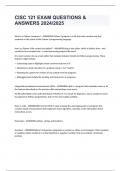Exam (elaborations)
CISC 121 EXAM QUESTIONS & ANSWERS 2024/2025
- Course
- Institution
CISC 121 EXAM QUESTIONS & ANSWERS 2024/2025 What is a Python 3 program? - ANSWERSA Python 3 program is a file that only contains text that conforms to the syntax of the Python 3 programming language How is a Python 3 file created and edited? - ANSWERSUsing a text editor, which is distinct f...
[Show more]



